The benefits and harms of pumpkin for the body: composition and properties of the vegetable, rules for its use
Pumpkin is a valuable and healthy food product. Hundreds of different dishes are prepared from it, the pulp is consumed fresh, boiled, baked, stewed, processed into caviar, puree, juice, and the seeds are used as a snack. It is well absorbed by the body and is used for dietary and baby food.
The vegetable is popular in folk medicine. Due to its rich chemical composition, it has a versatile effect on the body: normalizes metabolism, improves the functioning of the gastrointestinal tract, strengthens the heart, and saves from depression.
In the article we will consider in detail the beneficial properties and contraindications of pumpkin, methods of use as a food product and as a medicinal raw material.
Common pumpkin - composition and properties
Pumpkin is an annual herbaceous plant of the Cucurbitaceae family, a melon crop. Her homeland is Mexico. Even before our era, the vegetable was grown in the northern part of the Missouri and Mississippi River valleys. It was brought to Europe by the Spaniards in the 16th century.
Depending on the use, there are three types: fodder, decorative and table (for human consumption). Using the example of pumpkin (an edible variety), we will consider what vitamins and minerals it contains, what its medicinal properties are for various diseases, the consequences of its deficiency and excess.
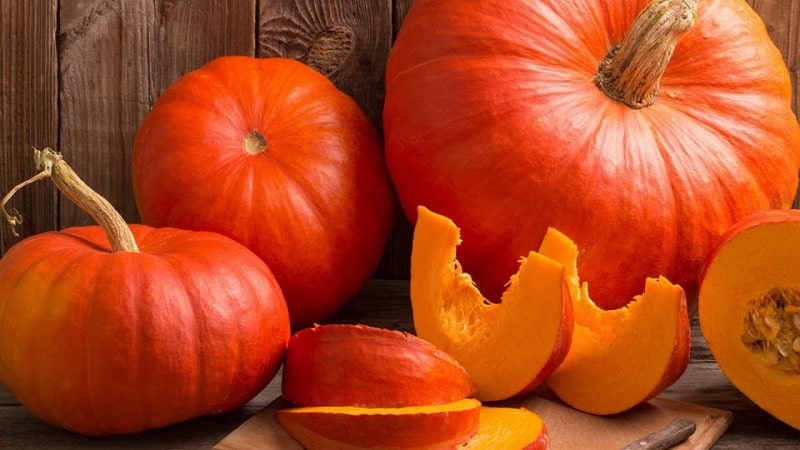
Composition, properties
Pumpkin has a unique chemical composition that saturates the body with useful micro- and macroelements and vitamins. A properly grown vegetable without the use of nitrates consists of 90% water, the rest comes from components such as:
- starch;
- carotene (5 mg per 100 g of weight, which is five times more than in carrots);
- vitamins A, B, C, E, K, T, PP;
- pectin;
- cellulose;
- a nicotinic acid;
- trace elements: zinc, copper, iodine, fluorine, cobalt;
- salts of calcium, iron, magnesium.
Pumpkin seeds are rich in fatty oils (up to 40%) containing oleic, stearic, and palmitic acids. In addition, the seeds contain essential oil, amino acids, vitamins B1, C, plant sterols, resinous substances, carotene, organic acids. The leaves of the plant are rich in vitamin C, and the flowers are rich in flavonoids and carotenoids.
Traditional medicine has long used pumpkin for medicinal purposes. The vegetable has a wide range of actions:
- helps with metabolic disorders;
- prevents or alleviates the course of diseases of the cardiovascular system, namely, reduces the risk of developing diseases such as atherosclerosis, coronary heart disease, hypertension, anemia;
- improves liver and kidney functions;
- has a calming effect;
- forms a mechanism of antimicrobial immunity;
- suppresses the growth of cancer cells;
- relieves depression.
Pumpkin seeds are effective against diseases caused by helminthic infestations. For purulent-inflammatory skin diseases, wounds and burns, a compress made from pumpkin pulp is used.
Advice! According to nutritionists, pumpkin is especially relevant and useful in winter, when the body is deficient in vitamins.With the help of a pumpkin menu, in a few days you can saturate the body with minerals, vitamins and other components necessary to ensure and maintain a person’s internal and external activity.
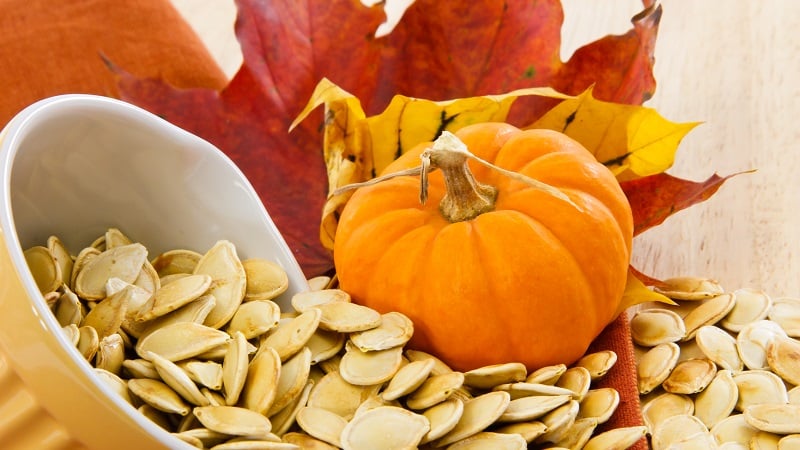
What vitamins and minerals does it contain?
Pumpkin is a storehouse of vitamins and minerals. The pulp of the fruit contains vitamins of group B (B1, B2, B5, B6, B9), A, C, E, D, K, T, PP.
The vegetable is also rich in microelements important for the body:
- calcium;
- phosphorus;
- zinc;
- iron;
- sulfur;
- potassium;
- chlorine;
- cobalt;
- calcium;
- magnesium;
- copper;
- fluorine;
- iodine;
- manganese.
The chemical composition may vary depending on the variety and growing conditions. Pumpkin is perfectly stored without losing its beneficial properties.
Calorie content and BZHU
Pumpkin is classified as a dietary food product. The calorie content per 100 g of raw vegetable is 22 kcal, after heat treatment - 25 kcal. The vegetable pulp contains practically no fat (0.3 g per 100 g), but is rich in carbohydrates (7.7 g) and proteins (1.3 g) necessary to saturate the body.
Pumpkin: benefits and harm to the body
The vegetable has a wide spectrum of action and has a positive effect on many pathological conditions.
Benefits of pumpkin:
- activates metabolism;
- regulates protein synthesis;
- improves calcium absorption and prevents its leaching;
- enhances bile secretion, removes heavy metal salts;
- prevents water and sodium retention;
- supports the functionality of the visual organs, moisturizes the eyes, protects from drying out;
- slows down the aging process;
- takes part in the formation of new cells;
- provides synthesis of steroid hormones;
- necessary for the proper functioning of the immune system;
- prevents the development of oncological processes, hypertension, atherosclerosis, anemia;
- ensures normal intrauterine development of the embryo;
- restores and supports epithelial tissues, accelerates the healing process of the dermis in case of damage;
- protects against infections of the upper respiratory tract, genitourinary system, colds;
- calms the nervous system;
- stabilizes high blood pressure;
- increases endurance and performance;
- normalizes weight.
Another advantage of pumpkin is its low calorie content. The vegetable is included in the diet menu; it is recommended for people who are obese or prone to obesity. It has been clinically proven that pumpkin is a powerful antioxidant, helps remove salts, toxins and toxic substances from the human body, normalizes metabolic processes, and removes excess fluid.
Fiber ensures quick satiety, which allows you to reduce food portions, and folic acid stimulates the production of “happiness hormones” and improves mood.
The pulp of pumpkin fruits is used in baby food. Due to the presence of a large number of vitamins, micro- and macroelements, it supports the development and growth of the child at the physiological level.
According to the WHO complementary feeding table, pumpkin is allowed for children aged eight months and older. and older, provided there are no contraindications. Children who regularly consume fruit pulp have a good night's sleep, are resistant to infections, and are less likely to suffer from acute respiratory viral infections and acute respiratory infections.
Important. Pumpkin seeds are healthy for men reproductive age (20-50 years). Their regular use reduces the risk of developing inflammatory disease of the prostate gland in men, maintaining normal size and function of the prostate.
At the same time, pumpkin requires reasonable and correct consumption. The consequences of an excess of vegetables in the diet can be an exacerbation of gastric and duodenal ulcers, gastritis with low acidity, and cholelithiasis. Possible vomiting and nausea, increased pain in the lower abdomen.
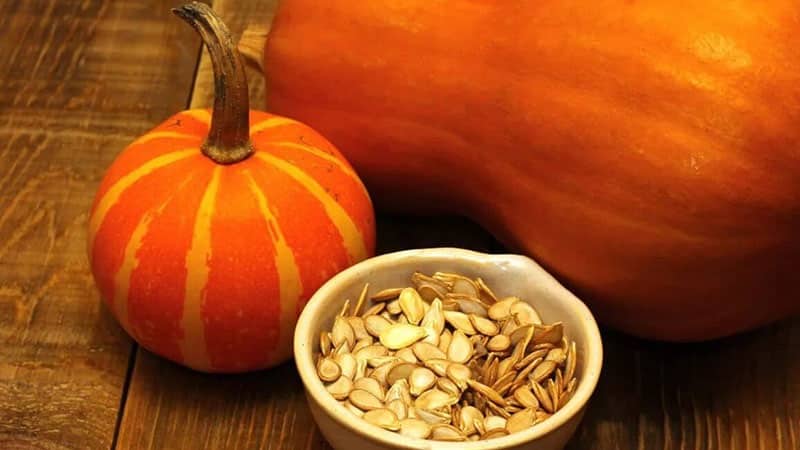
Medicinal properties for various diseases
Traditional medicine advises using pumpkin for the treatment and prevention of diseases such as:
- hypertension and atherosclerosis - improves the condition of the heart, increases the elasticity of the walls of blood vessels, saturates the body with magnesium, potassium and iron, necessary for the normal functioning of the myocardium, prevents the formation of pockets of cholesterol and lipid deposits, blockage of blood vessels, and circulatory disorders;
- liver cirrhosis and other gastrointestinal diseases - neutralizes free radicals, increases the protection of mucous membranes, inhibits inflammatory processes, prevents the growth and reproduction of pathogenic microorganisms, has diuretic and antioxidant properties, activates the functioning of the digestive organs;
- anemia - replenishes iron deficiency, reduces the severity of symptoms, alleviates the course of the disease;
- impotence - stabilizes the functions of the prostate gland, increases sexual stamina;
- depression - has a calming effect on the nervous system, improves sleep, improves mood;
- wounds and burns - accelerates healing, supports and restores epithelial tissue;
- obesity - improves digestion, activates metabolism, removes excess fluid, and due to the presence of fiber provides quick saturation;
- gout, rheumatic diseases - suppresses the inflammatory process, reduces puffiness and swelling at the site of the lesion, improves the condition of osteochondral tissue, increases joint mobility, and slows the progression of destructive changes.
It is recommended to consume pumpkin pulp for women during the menopausal period. The pumpkin menu will relieve nervous tension, ease the severity of symptoms, and improve general condition.
Use in cooking
All parts of the vegetable are used in cooking. The fruits are consumed fresh or after heat treatment (boiled, baked, steamed), processed into juice, caviar, mashed potatoes. Unripe fruits are salted and pickled. First courses (soup, puree soup) are prepared from the pulp, served as a side dish, added to salads, baked goods, and used to make jam, marmalade, candied fruits and other desserts.
Pumpkin seeds consumed between main meals as a snack, raw or fried. An analogue of sesame milk (or almond milk) is obtained from seeds crushed in a blend and pre-soaked in water. In addition, pumpkin seeds are used as an ingredient in Mexican mole sauce. Pumpkin oil is obtained from roasted seeds, which is in demand not only in cooking, but also in cosmetology.
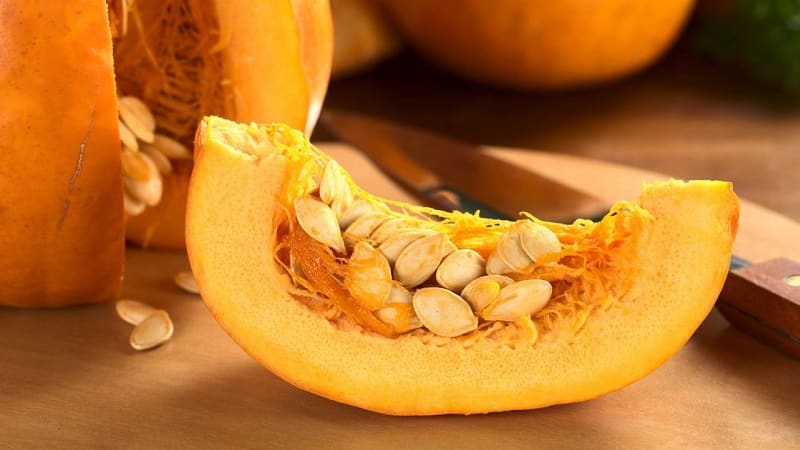
In folk medicine
For medicinal purposes, pumpkin pulp is used raw; decoctions are prepared from the peel or pulp; pumpkin juice is consumed as a separate product or in combination with other vegetable/fruit juices. The ground pulp is applied as a compress to wounds, burns, swelling, and places of inflammation. A hepatoprotective agent for oral administration, ointments and rubs for external use are prepared based on pumpkin seed oil..
Pumpkin seeds are used as an anthelmintic. Other healing effects boil down to the ability to suppress inflammatory processes, increase the density and elasticity of bone tissue, and increase its endurance. The product is used to treat rheumatic diseases, in particular arthritis and arthrosis. In addition, pumpkin seeds stabilize blood pressure, lower blood cholesterol levels, and help cure prostatitis.
Usage guidelines for children, men and women
How much pumpkin you can eat per day without harm to your health depends on your diet, age, gender and the presence of concomitant diseases. The average norm for women and men is 300-400 g per day in several doses, for children - half as much. Such restrictions are associated with the presence of carotene in the composition, an excess of which causes lethargy, drowsiness, yellowing of the skin, vomiting, nausea, and headaches.
The optimal amount of pumpkin juice is 200 ml per day for an adult, 100-150 ml for children. To enhance the medicinal properties and improve the taste, pumpkin juice is diluted with apple, orange, carrot, beet, cabbage, and celery juice.
Nutritionists recommend that adults consume pumpkin seeds in the amount of 20 g per day, provided that other vegetable fats are present in the diet. If any other fats are completely excluded, then the daily seed intake increases to 50 g.
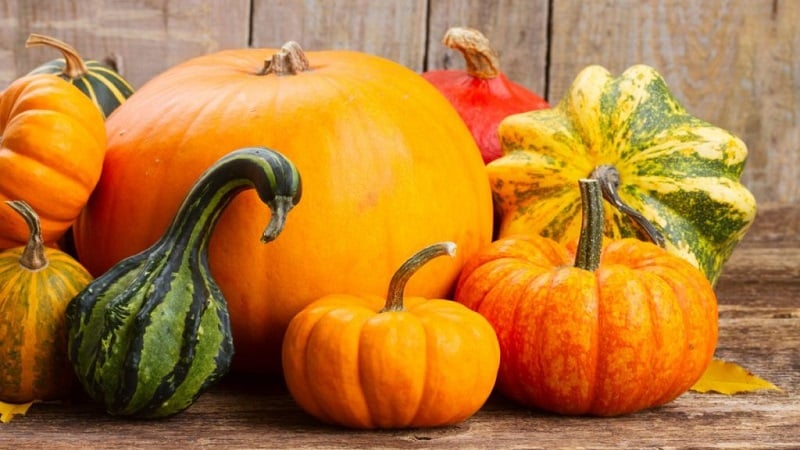
Contraindications
An allergy to the vegetable and its components completely excludes the possibility of using pumpkin, seeds, pumpkin juice. Relative contraindications, the presence of which indicates a significant health hazard and the need to take precautions, include diseases and pathological conditions such as:
- peptic ulcer of the stomach and duodenum. Components of the chemical composition, in particular acids, can irritate defects in the gastric mucosa and underlying tissues;
- diabetes. The vegetable contains sucrose, glucose, fructose, which are recommended to be limited to patients with a deficiency in the formation of their own insulin and elevated blood glucose levels;
- gastritis with low acidity.
Reference! At gastritis With low acidity, it is forbidden to eat pumpkin raw. It is pre-cooked, baked, stewed, so it is easier to digest, breaks down faster, and does not cause discomfort or worsening pain.
It is not recommended to consume pumpkin seeds for pregnant women, so as not to provoke premature labor. Baked and steamed vegetables have a laxative effect and are therefore contraindicated for people suffering from intestinal disorders.

Conclusion
Pumpkin is a food product with a unique chemical composition and pleasant taste. It is widely used both in cooking and in folk medicine. The pumpkin menu has a positive effect on the cardiovascular, digestive, and nervous systems, the condition of the skin, nails, and hair, relieves constipation and excess weight, and increases vitality.
However, in order to achieve results and avoid unwanted side effects, it is important to adhere to certain rules for consuming vegetables.The question of the advisability of using pumpkin and its components for medicinal purposes should be discussed with your doctor in advance.
Thanks for the informative information. I would never have thought that pumpkin could be so healthy and tasty.